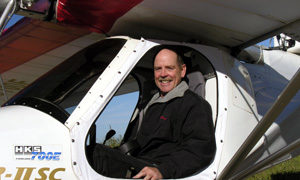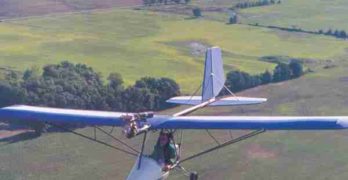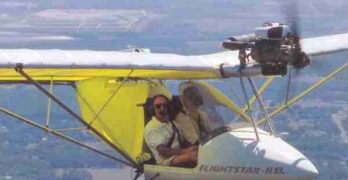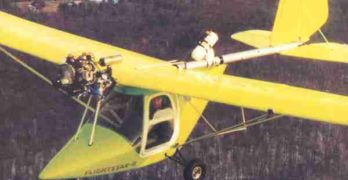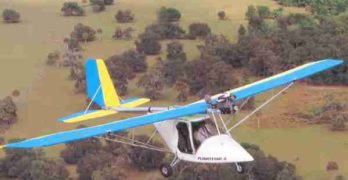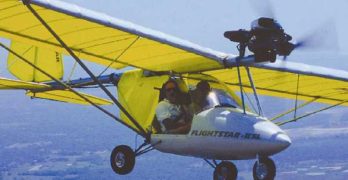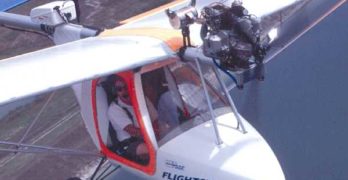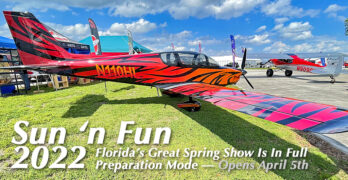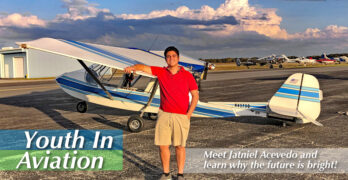On a glorious fall day over the undulating hills of northeast Connecticut, I returned to flight after a five-month hiatus. Encouraged and accompanied by my old friend Tom Peghiny we enjoyed an hour sightseeing flight over the verdant countryside surrounding Tom’s Flightstar Sportplanes enterprise at the Woodstock airport. Gosh, it felt great to get back in the air! *** With the first revolution of the wheels I noticed how light the Flightstar seemed. I’ve done most of my flying in Light-Sport Aircraft lately and I guess I’d forgotten just how light ultralights can feel. We left the ground in a couple hundred feet lifted by a HKS 700E four stroke distributed by HPower. In an age of $100,000 LSA, this $25,000 Flightstar IISC certainly seems affordable to plenty of Americans. At 400 pounds less than LSA at gross, turns were pleasant low-gee maneuvers.
Search Results for : Flightstar
Not finding exactly what you expected? Try our advanced search option.
Select a manufacturer to go straight to all our content about that manufacturer.
Select an aircraft model to go straight to all our content about that model.
Flightstar Classic
A great old name has returned! The Flightstar is back. Actually, the design has survived various ownership changes quite well. The original Pioneer Flightstar became the Argentine Aviastar. Now original designer, Tom Peghiny, has bought the plane and the name.
It’s all-American again, too, made in the USA. Above you see the F.A.R. Part 103-legal version, the Flightstar Classic. The Classic has a big brother single seater and of course, a two-seat trainer. The Classic is the company’s primary fun machine, though.
All the Flightstars were designed under accepted engineering methods. They’ve also been given the touch by Peghiny, an ultralight pioneer who aviation business experience dates back to his teens. It’s easy to see this successful combination if you examine individual component design and finish.
The Flightstar has an avid following of five hundred owners who love the way their planes fly. The Classic has simple features and low price while maintaining wonderful handling qualities.
Flightstar Inc. — Flightstar II SL Tailback
“New & Improved” boasts the advertising for the Flightstar IISL as it was introduced at the start of the 1999 season. Indeed, the statement proved to be more than a catchy advertising slogan. The already-popular ultralight from the Connecticut company managed to go one better than earlier models.
A series of changes subtly advanced the state of the art for one of America’s best ultralights. A new cabin fairing was cunningly reshaped to combine smoothly with a new, curvier windscreen. The aft-cabin fabric fairing was made leaner and smaller yet more efficient. And a new engine cowling improved cooling for the Rotax 503 engine installation.
The combination of front and rear fairing harmonized to bring smoother touchdowns eliminating the one nagging challenge I’d found in the older IISL. Making consistently smooth landing roundouts is now child’s play. Builders will also appreciate the easier fit of the new fiberglass parts and shipping is more compact (therefore cheaper) than ever due to the change.
Flightstar Inc. — Flightstar II + HKS Engine
Daring to take on deeply entrenched Rotax, Flightstar/H-Power has introduced the first light aviation four-stroke engine to see broad acceptance. Joined with their smoothly contoured Flightstar II, you can have a deluxe ultralight or lightplane that will provide years of flying enjoyment.
While two strokes do the job for most ultralight enthusiasts, the four stroke 700E engine from HKS of Japan offer assurances some pilots demand. With its particular strength of mid-range torque, the HKS engine brings interesting differences. Pull up the nose while revolutions are set in the 4000s and the HKS will haul the Flightstar II aloft with no evidence of prop loading common among two stroke engines.
Flightstar still sells lots of their very popular IISL models, but on this lighter aircraft, they recommend the Rotax 503. However, now that the same company has adapted the stronger HKS engine, sales are soaring for their Flightstar II with its beautifully formed all-fiberglass cockpit enclosure.
Flightstar II
The popular Flightstar is solidly an American aircraft again after an excursion with overseas ownership. Original designer, Tom Peghiny, and his partner, Sparky LaMontagne, are majority owners in the Connecticut-based ultralight manufacturer. They’ve introduced four models to the community: Flightstar Classic (277 engine), Spyder (447-powered single place), Formula (deluxe full enclosure single seater) and Flightstar (top of the line two-place aircraft).
The Flightstar line distinguishes itself by featuring well engineered designs with cleanly executed hardware on a sleek, solid design. As they pass by in an airshow demonstration, viewers are pleased by the quiet performance of the machines. Factory pilots fly their two place model with the lighter 503 engine; it’s more than enough engine though you can add the more powerful 582. They go fast as well as slow and handle well at either end of the envelope. Present models offer flaps to further extend the speed range.
Efficiency is a watchword with the Flightstars.
Flightstar II SL
Since Tom Peghiny and partner Spark Lamontagne first lightened the Flightstar and named one model the II SL (for “Sport Light”), they haven’t been able to sit still and simply admire their work. From our first pilot’s report on the SL 3 years ago,1 the two have tweaked and adjusted the model to find even better qualities.
A new front and aft fairing are part of the package, and the latter you might notice rather quickly. Virtually all the rest of the improvements are subtle things. In fact, that word is a hallmark of Flightstar innovation.
No surprise then that the company should adopt “New and Improved” as its new advertising headline to assure you know about the changes.
Better and Better
I’ve followed the Flightstar from its first flight, when it wasn’t even the Flightstar. This design – which once crossed the Atlantic – is from the inventive mind of Swiss national Hans Gygax, and became the rather gaudy 440ST.
Flightstar II Sport Cabin
In August 1999,Ultralight Flying! reported on the Flightstar II SL. Thirteen months later, another report is needed as, once again, Tom Peghiny and Spark Lamontagne have upgraded their principal selling model.
Flightstar is the name of the plane and Flightstar Sportplanes is the name of the company, and “refinement” ought to be permanently attached. I’ve followed many ultralights over many years. Some have changed a lot, some have seen almost no change. The Flightstar has almost constantly evolved.
Why change this successful design? After all, it costs money to design, test and build new parts inventories. It takes time and more money to update assembly manuals. Why do all this if the ultralight is doing well? The reason is simple: to make a better product that more people will buy. At least the answer sounds simple; in fact, it may be surprisingly complicated to achieve.
Before we get into how the ultralight flies, let’s review what makes this Flightstar II SC (Sport Cabin) different from the Flightstar II SL (Sport Light).
PREVIEW: Sun ‘n Fun 2022 — What I’m Checking Out at the Season-Opening Airshow
When Sun ‘n Fun 2022 starts, a signal can be heard ’round the world. The message? It’s time for a new season of recreational flying.
After we got the LSA Mall set up to receive a flock of airplanes, I was able to get around the sprawling Sun ‘n Fun campus to see what else I planned to cover as the show begins. It starts Tuesday the 5th and runs through Sunday the 10th. I hope you can make it but if not, I’ll be reporting on the aircraft that I think may interest you.
One extra treat — for me and for you: my YouTube partner, Videoman Dave has been able to escape Canada and turned up at Sun ‘n Fun. We’ll return to our usual drill of roving around doing video interviews. I’m happy as Dave is highly knowledgeable about the same kind of aircraft I report and we’ve learned to work well together, making somewhere approaching 1,000 videos.
Youth In Aviation — Is Aviation in Trouble? Or, Are Kids Finding their Way into the Sky?
I don’t believe the line about young people ignoring aviation. Maybe we older pilots don’t see enough action at flight schools, but not all flying happens at major flight centers.
Lots of other avenues are available. For example, EAA has an endowment from the late-aviation philanthropist James Ray that allows the Oshkosh organization to give scholarships for around 100 pilots per year. LAMA is working with EAA right now to add more scholarships; these will be specific to Sport Pilot and must occur in Light-Sport Aircraft. EAA chapters around the country can participate.
Regarding youth coming into aviation, my earlier work shows key numbers. Here’s part of what I wrote…
Most pilots I know think the pilot population is graying quickly and that we may be in danger of running out of pilots. GAMA’s stats say otherwise. The biggest single category may be what you expect with those aged 50-64 counting 179,277 pilots but the surprising second largest segment is close behind.
The New Part 103 List — Current Draft List Shows MORE Producers …Surprised?
UPDATED (again!) 12/11/20: Still refining the list. —DJ
A great many of you read the article about the new Part 103 List. Your enthusiasm plus lots of comments reflect the strong interest generated by these lightest, most-affordable, and fun-to-fly aircraft.
With input from readers and through more research, I have increased the draft list to the one you see below, now 53 producers strong! Honestly… I expect even more.
Many readers were surprised by the number of producers of these aircraft that too many pilots thought were dead and buried by Light-Sport Aircraft and FAA’s requirement that previous two-seat ultralight trainers had to leave paid flight instruction and become private aircraft.
As the list shows — and as my plan to attempt counting the number of aircraft built every year proves — Part 103 Ultralight Vehicles are indeed alive and thriving.
Keep Helping, Please!
If these aircraft interest you, please review the list and tell me of any additional producers I did not include.
- 1
- 2
- 3
- …
- 9
- Next Page »


